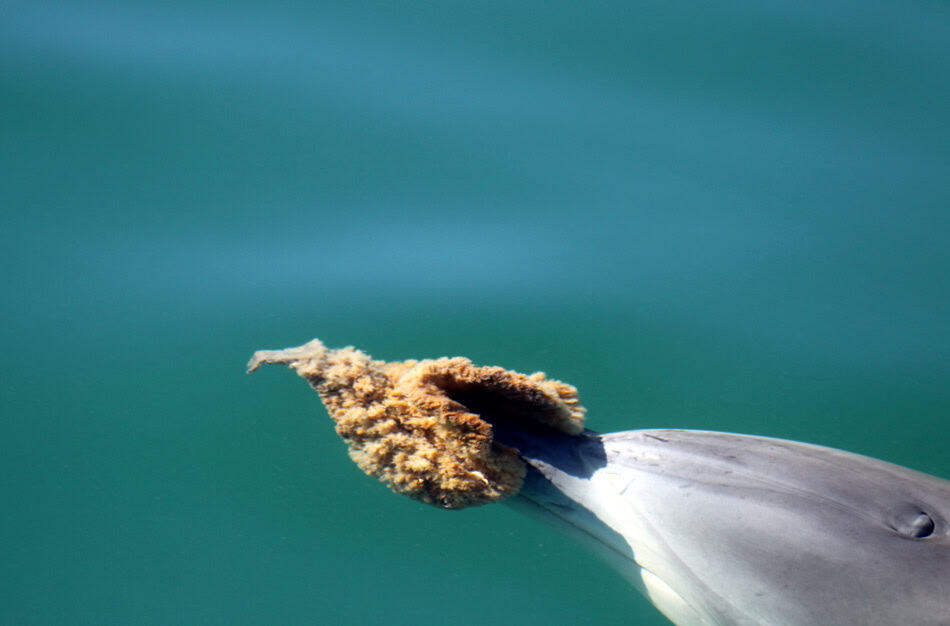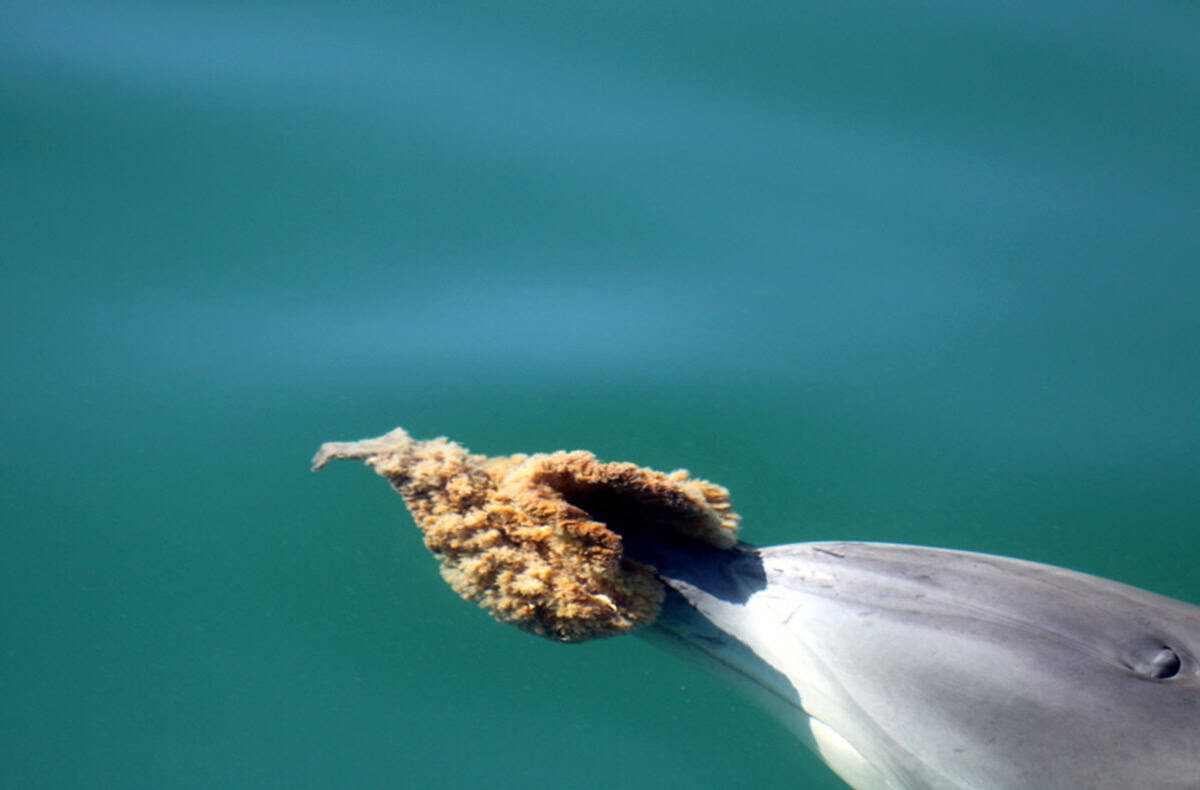 Sponge face. Some dolphins in Shark Bay use marine sponges as a fishing tool. Credit: Eric Patterson
Sponge face. Some dolphins in Shark Bay use marine sponges as a fishing tool. Credit: Eric Patterson
One dolphin swam past, her nose oddly enlarged. On a closer look, the bulb was a marine sponge — wedged tightly onto her beak like a soft, fleshy glove. She was not playing. She was hunting.
Off the coast of Shark Bay, Western Australia, a select group of wild bottlenose dolphins have developed one of the animal kingdom’s most curious tool tricks: they forage with sponges. And not just any sponges — these dolphins choose specific, bowl-shaped ones from the ocean floor, fit them over their beaks, and then plunge their faces into the sediment in search of hidden fish.
Now, a new study published in Royal Society Open Science has revealed why so few dolphins learn this peculiar behavior and why those who do must spend years mastering it.
“It has a muffling effect in the way that a mask might,” Ellen Jacobs, a marine biologist at Aarhus University and co-lead author of the study, told Associated Press. “Everything looks a little bit weird, but you can still learn how to compensate.”
A Dolphin Culture Beneath the Waves
Sponging, as scientists call it, isn’t new. Researchers first noticed dolphins using sea sponges in Shark Bay back in 1984. For decades, biologists like Jacobs and Georgetown University’s Janet Mann have tracked this tradition, revealing a striking pattern: only about 5% of the local dolphin population does it. The practitioners are mostly female, and the behavior is passed from mother to offspring — one of the clearest examples of non-human culture in the wild.
But the new research finally shows why this tradition remains so exclusive.
Using underwater recordings and sophisticated computer modeling, Jacobs and her team demonstrated that wearing a sponge interferes with the dolphins’ echolocation — the same high-frequency clicks they use to “see” through sound. Dolphins emit these clicks from specialized tissues in their heads, and then receive the echoes through their lower jaws.
 Credit: Ewa Krzyszczyk, Public Library of Science.
Credit: Ewa Krzyszczyk, Public Library of Science.
With a sponge on their beak, those echoes become distorted. The sponge alters both the outgoing signal and the returning echo, making it harder for the dolphin to identify the exact location of prey.
Still, sponge-wearing dolphins manage to make it work.
“This is like hunting when you’re blindfolded — you’ve got to be very good, very well-trained to pull it off,” said Mauricio Cantor, a marine biologist at Oregon State University who was not involved in the study.
The Cost of Innovation, And the Payoff
So why do they bother? Because for those who master it, the payoff is worth it.
Dolphins typically chase fish in the open sea using echolocation to spot the swim bladders (air-filled sacs that help fish float), which produce strong echoes. But the fish hiding under the sand in Shark Bay’s deep channels, like the barred sandperch, don’t have swim bladders. That makes them almost invisible to sonar. They are also fatty and energy-rich — a nutritious meal, if you can dig them up.
Without a sponge, probing for these fish would be risky. The seafloor is littered with sharp shells, rocks, and stinging animals like scorpionfish and stonefish. The sponge serves as soft armor, protecting the dolphin’s sensitive snout while sweeping the sand.
But learning to hunt with a sponge is anything but simple. Juvenile dolphins take years to get it right. They have to learn not just to find the right kind of sponge — typically a cone-shaped species called Echinodictyum mesenterinum — but also how to process distorted echoes. It’s not just about tool use. It’s about recalibrating an entire sensory system.
“It takes them many years to learn this special hunting skill — not everybody sticks with it,” Boris Worm, a marine ecologist at Dalhousie University who was not part of the study, told AP.
The challenge may help explain why sponging remains confined to a few family lines. In Shark Bay, only the daughters (and some sons) of sponging mothers adopt the practice. Even dolphins that frequently associate with spongers rarely try it themselves.
An Underwater Trade-Off
To test this idea, the researchers used a technique called finite element modeling, essentially simulating dolphin sonar through a digital sponge.
They tested how sound waves moved through two types of sponges: the preferred Echinodictyum, which has a cone-like shape, and a less-used basket-shaped sponge called Ircinia. The differences were striking.
The cone-shaped sponge actually helped focus the dolphin’s sonar beam, acting almost like an acoustic funnel. The basket-shaped sponge, in contrast, scattered the signal and dramatically weakened the returning echoes.
The study also showed that barnacles growing inside the sponge tissue didn’t significantly change the sound distortion. But the sponge’s overall shape and structure had a major impact.
That might help explain why dolphins favor certain sponge species. In 35 years of data from Shark Bay, about 70% of the sponges used are Echinodictyum, compared to only 20% Ircinia. This choice could be strategic. A cone-shaped sponge may reduce the sonar distortion and give the dolphin a clearer read on buried prey.
A Maternal Inheritance
But even with the best sponge, hunting this way is not for amateurs. Dolphin calves spend three to four years with their mothers, observing their every move. This long dependency period, which is rare in the animal kingdom, gives them time to absorb the complex skill.
“[Sponging] is only ever passed down from mother to offspring,” said Mann, a co-author of the study and longtime expert in dolphin behavior.
Despite this close maternal bond, not all offspring adopt the technique. Daughters are more likely to sponge than sons. And male dolphins that do try it tend to give it up. Researchers believe that’s because males prioritize social bonding over foraging precision, a strategy that helps them later secure mates.
In contrast, females — who must feed and raise calves over several years — benefit more from developing efficient, specialized hunting skills.
Tool use often comes at a cost: it’s time-consuming, difficult to learn, and only worth it if there’s a reliable payoff. Like Galápagos finches that use cactus spines to extract insects only when food is scarce, dolphins turn to sponging to access prey that would otherwise remain hidden.
Nevertheless, tool use among dolphins remains rather rare. Even among animals known for intelligence — chimps, crows, otters — tools are often a niche behavior. But the case of Shark Bay’s sponging dolphins shows how a small cultural innovation can persist for decades, passed down through family lines.
And now, thanks to advanced modeling and years of fieldwork, scientists are beginning to understand why.
